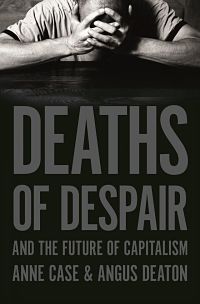Anne Case on Deaths of Despair

Political violence aside, the 20th century saw great progress. Looking at health progress, as one example, Princeton University economist Anne Case notes it was a century of expanding lifetimes.
“Just to take one particular group,” she tells interviewer David Edmonds in this Social Science Bites podcast, “if you look at whites aged 45 to 54 in the U.S., back in 1900 the death rate was 1,500 per 100,000. By the end of the century, it was down below 400 per 100,000.
“The risk of dying just fell dramatically and fairly smoothly. There were a couple of spikes — one was the 1918 flu epidemic — and a little plateau in the 1960s when people were dying from having smoked heavily in their 20s and 30s and 40s. But people stopped smoking, there was a medical advance as antihypertensives came on the scene, and progress continued from 1970 through to the end of the century.”
Even stubborn health disparities – such as the life expectancy gaps between say whites and blacks, or between the rich and the poor – narrowed in the century’s second half.
“We thought that sort of progress should continue,” Case says. But as she and fellow Princeton economist Angus Deaton found as they sleuthed through the data, starting in the 1990s progress had reversed for a fairly large demographic in the U.S. population.

“[W]hat Angus and I found was that after literally a century of progress, among whites without a college degree – these would be people without a four-year degree in the U.S. – mortality rates stopped falling and actually started to rise.”
The trend was clear: looking at figures from the 1990s to the most recent data available from 2018, mortality among middle-aged, non-college-educated white Americans rose, stalled, then rose again.
“This was stunning news to us and we thought we must have done something wrong because this never happens, or if it had happened, it would have been reported,” Case admits. But it was news, and Case and Deaton’s findings and analysis – that behaviors like drug addiction, suicide and alcohol addiction were driving the numbers – created a furor. Citing sociologist Emile Durkheim’s argument that suicide is more likely when social integration breaks down, Case explains, “We think of all of these as a form of suicide – not necessarily that a drug addict wants to take him or herself out, but that it leads to that eventually.”
Meanwhile, Case and Deaton’s shorthand expression ‘deaths of despair’ entered the common –not just the academic social science – lexicon. (It helped that they were speaking publicly about this “group that just wasn’t on anyone’s radar” at roughly the same time that a demographic both similar and similarly ‘unknown’ was seen as a surprise well of strength for the political maverick Donald Trump.)
Deaths of Despair and the Future of Capitalism is also the name of the new bestselling book that Case and Deaton, her husband, have written for Princeton University Press. (Deaton, a Nobel laureate in economics, has also appeared on Social Science Bites.) The book looks at the physical and mental causes of these deaths – Case and Deaton count 150,000 of them in 2018 alone – and how aspects of America’s unique medical and pharmaceutical system have resulted in this unique tragedy.
Case explains that these deaths of despair didn’t suddenly arise in the 1990s, but they had been obscured by advances made in treating heart disease (and obesity, despair, drugs, alcohol are all hard on the heart). “As deaths of despair got larger and larger, it would have taken more progress against heart disease for this to continue to fly under the radar. Instead what happened was we stopped making progress against heart disease.”
Also in the 1990s, prescription opioids became widely available in the United States – “a self-inflicted wound,” Case says that made the existing trend “horrifically” worse. “In the U.S. in the mid-1990s Oxycontin was allowed onto the streets. Any doctor with a script could prescribe it. It’s basically heroin in pill form with an FDA label on it, and they sprinkled it like jelly beans. It landed on very fertile soil.”
Between opioids and existing problems with America’s mostly private health care system, deaths from despair keep rising.
What might end this cycle? Something dramatic, Case says. And perhaps something already creating drama …
“We think something is going to have to break, and break badly, in order for us to see reform. Maybe, possibly, COVID-19 is breaking things really badly and this might be a time when enough people in the middle of the distribution start talking about reform, then it might be possible to see change.”
Anne Case is the Alexander Stewart 1886 Professor of Economics and Public Affairs, Emeritus at Princeton, where she directs the Research Program in Development Studies. She’s received numerous awards for her work on the nexus between economic health and physical health, including the Kenneth J. Arrow Prize in Health Economics from the International Health Economics Association and the Cozzarelli Prize from the Proceedings of the National Academy of Sciences. She is a research associate of the National Bureau of Economic Research, a fellow of the Econometric Society, and an affiliate of the Southern Africa Labour and Development Research Unit at the University of Cape Town. Case is a member of the National Academy of Medicine, the American Academy of Arts and Sciences, and the American Philosophical Society.
To download an MP3 of this podcast, right-click HERE and save.
For a complete listing of past Social Science Bites podcasts, click HERE. You can follow Bites on Twitter @socialscibites and David Edmonds @DavidEdmonds100.































































































